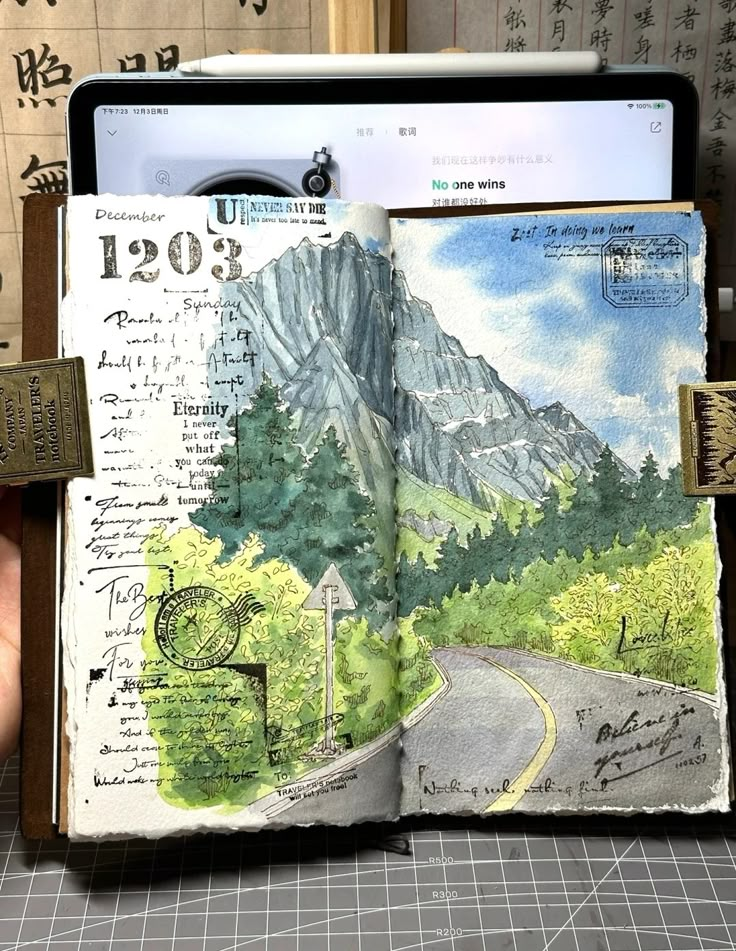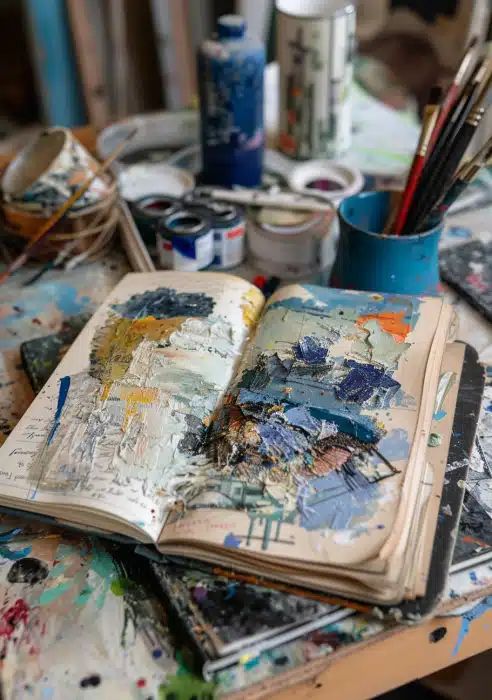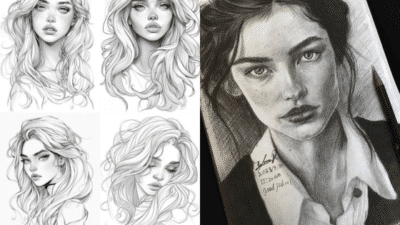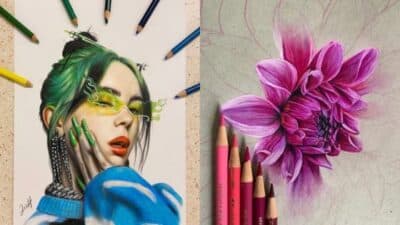Visual journal drawing is an engaging way to record your thoughts, observations, and experiences through the synergy of images and words. By combining art and journaling, you create a unique, personal narrative that reflects your creative journey. This method helps you tap into your imagination, fostering both artistic and personal growth.
When starting a visual journal, consider the benefits and fundamental supplies that will aid your creative process. The right tools, such as high-performing papers and quality drawing supplies, can enhance the experience. Experimenting with various themes and styles allows you to explore different artistic techniques, pushing the boundaries of your creativity.
Adopting visual journaling as part of your routine adds structure to your creative expression while encouraging spontaneity and freedom. This practice not only enhances your artistic skills but also supports personal development by offering a space to reflect on your thoughts and emotions. Dive into this artistic journey and uncover new dimensions of your inner artist.
Key Takeaways
- Visual journal drawing combines art and journaling for a creative experience.
- Selecting the right supplies enhances your visual journaling practice.
- Visual journals promote personal and artistic growth.


Understanding Visual Journals
Visual journals combine art and text to create a multifaceted expression of thoughts and experiences. These journals serve as a creative outlet, enabling you to explore your imagination and reflect through drawings, collages, and written entries.
Historical Context and Evolution
Visual journals have evolved significantly over time. Originating as illustrated diaries in the 15th century, these personal records were often filled with sketches and annotations. As time progressed, they became more prevalent during the Renaissance, as artists used them to experiment with techniques and capture ideas.
In contemporary times, technological advancements have influenced the format and accessibility of visual journaling. Today, digital visual journals also join their traditional counterparts, making this artistic pursuit more widely available and accommodating diverse artistic preferences.
Types of Visual Journals
There are various types of visual journals, each emphasizing different aspects of creativity and self-expression. Art journals center around drawing, painting, and mixed media, often used by artists to hone skills or track creative processes. Travel journals document experiences and sights through sketches and notes, preserving memories in a personalized format.
Reflective journals combine visual elements with introspective writing, fostering personal growth and mindfulness. Digital journals incorporate digital media, offering a virtual space for those inclined toward electronic expressions. Each type provides unique avenues for exploring your creativity and documenting your journey in a way that resonates with personal preferences.


Fundamental Supplies for Visual Journaling
Visual journaling requires a selection of art supplies that cater to both creativity and functionality. Key supplies include an ideal journal, a variety of drawing mediums, and additional tools to enhance your artwork.
Choosing the Right Journal
When selecting a journal, consider the type of paper and its compatibility with your preferred mediums. Look for drawing paper that is thick enough to hold 42 sheets without bleeding. This is crucial if you plan to use watercolors or acrylics. Journals with mixed media capabilities are ideal, as they can handle pencil, pastel, and charcoal. Opt for a size that suits your style; larger sizes offer more space for detailed work, while smaller journals are portable and convenient.
Essential Drawing Mediums
A range of drawing mediums enriches your visual journaling experience. Pencils are versatile and fundamental for sketching. Adding colored pencils can introduce vividness and detail to your work. Experiment with pastels for softer transitions and depth. Markers offer bold strokes, perfect for creating striking highlights or outlines. Charcoal provides deep, dramatic shading, enhancing the texture. Combining these mediums allows for diverse expressions, turning your journal into a rich tapestry of creativity.
Additional Artistic Tools
To complement your journals and mediums, include tools that facilitate creativity and organization. Brushes are necessary if you’re working with watercolor or acrylic. Look for a variety of sizes for different effects. Keep a selection of adhesives handy for collage work, adding layers and dimensions to your pages. A mixed media toolkit might incorporate a broad range of supplies, catering to both intricate details and broad expressive strokes. These additional tools allow for endless exploration, keeping your visual journaling experience both dynamic and fulfilling.


Creative Techniques and Expression
Embracing creativity in visual journaling can lead to the exploration of various techniques that enrich your artistic expression. This includes experimenting with layering, media mixing, and color dynamics to help you connect with your emotions and enhance the narrative of your work.
Layering and Texture
Layering adds depth and complexity to your visual journal. It involves building multiple layers using different materials and techniques.
You might start with watercolor washes for a soft background. You could then add stamps, stencils, or drawings to create intricate details. Use materials like tissue paper or gauze for added texture. This method encourages you to reflect on the creative process as you explore unity between the elements, seamlessly blending them into a cohesive piece.
Mixing Media for Impact
Mixing different media can create striking visual effects and enrich your journal pages. Consider combining ink, charcoal, acrylics, and pastels. Each medium brings its unique qualities and textures.
Experiment with these materials to produce contrast and enhance the visual narrative. For example, bold ink lines can highlight softer watercolor areas. This integration of media invites you to delve deeper into creative exploration, allowing for a more engaging storytelling approach through varied textures and tones.
Colors and Emotions
Colors evoke emotions and can transform the mood of your visual journal. Warm hues like reds and oranges can symbolize energy and passion, while cool tones like blues and greens often represent calmness and reflection.
Experiment with color palettes to express your emotional themes or reactions creatively. Your choices of color can enhance storytelling by creating a specific atmosphere or reflecting personal experiences. Understanding the emotional impact of colors can lead to more meaningful and resonant journaling.


Practical Aspects of Visual Journal Keeping
Visual journals serve as a tool for creativity and reflection, requiring methodical planning for effective use. Key practices include organizing your journal and cultivating journaling as a consistent habit.
Organizational Strategies
When keeping a visual journal, selection of materials plays a crucial role. High-performing papers are ideal for versatility, accommodating both wet and dry media. Consider journals with wire binding that allow the pages to lie flat, making them user-friendly and practical for diverse art styles.
The cover design should reflect your personal style. It not only protects the contents but also serves as an inspiration before you even open the first page. Some artists dedicate the first page to creating a visual index or using numbered pages that aid quick navigation, ensuring the journal remains a well-structured tool for creativity.
Journaling as a Habit
To make visual journaling effective, you must develop it as a regular habit. Setting aside a specific time daily boosts this practice. Some people find morning hours suitable, inspired by the concept of “morning pages,” where you engage in art and reflective writing.
Keep your journal accessible in your studio art space. This encourages spontaneous entries when inspiration strikes. Pair journaling with another routine, like having your morning coffee, to embed it seamlessly into your daily life. Adopting this habit opens avenues for continuous personal reflection and creative enhancement.


Visual Journaling for Personal Growth
Visual journaling can be a powerful tool for personal growth, offering both reflective and creative opportunities. By engaging in this practice, you can work through complex emotions and challenge creative limitations in a structured, therapeutic space.
Reflection and Healing
Visual journaling provides a reflective space to explore thoughts and feelings beyond what words alone can express. The combination of writing and drawing helps you process emotions and gain new insights into personal challenges.
Creating a visual record of your experiences allows you to address fears and confront them visually. You may find healing in expressing difficult emotions, as the artistic process enables you to externalize internal struggles.
Through this exploration, new pathways towards self-discovery and healing often emerge. By continually engaging with your visual journal, you can track your growth and progress over time, fostering deeper personal insight and resilience.
Overcoming Creative Blocks
Visual journaling is an effective method to overcome creative blocks and refresh your perspective. It encourages you to experiment with different materials, colors, and patterns, freeing you from the constraints of perfectionism and fear of failure.
When you’re stuck, the act of drawing or doodling can stimulate new ideas, leading to unexpected solutions. By giving yourself the freedom to make mistakes and embrace imperfection, you cultivate a more open mindset, enhancing your creative exploration.
A consistent visual journaling practice gradually builds confidence in your creative abilities. As you reflect on past entries, you may uncover patterns or themes that ignite inspiration and propel you past previously held blocks.
- 8.0Kshares
- Facebook0
- Pinterest8.0K
- Twitter0



